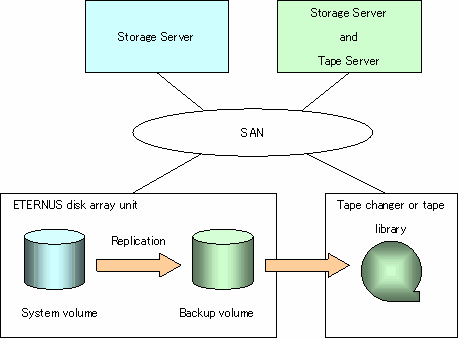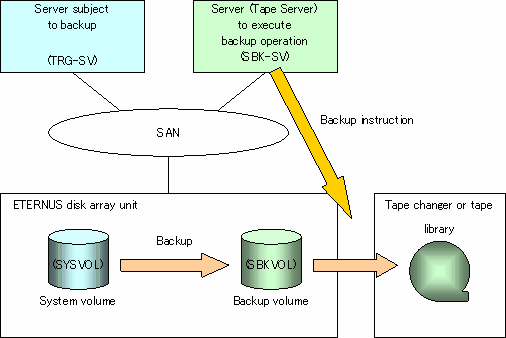

| ETERNUS SF AdvancedCopy Manager Operator's Guide for Tape Backup Option 13.0 -Microsoft(R) Windows(R) 2000/Microsoft(R) Windows Sever(TM) 2003-, -Solaris-, -HP-UX-, -Linux-, -AIX- |
Contents
Index
 
|
This chapter explains how AdvancedCopy Manager can be used in operations to back up and restore system volumes.
In an environment where the system volume is allocated to a machine in the ETERNUS storage system, the system volume can be backed up and restored with server-to-server replication using the replication management function.
The destination volume that is the backup destination of the system volume can be registered as a transaction volume for the tape backup operation. If the volume is so registered, the backup data of the system volume can be managed on tape media.


To allocate the system volume to the ETERNUS disk array unit, a hardware device that supports system startup from an external disk array is required.
Because the system (server) must be stopped in order to back up or restore its system volume, a server used for backup operations is required. That is, at least two servers are required for this operation.


If the backup source server and the server used for backup operations have different operating systems, the backup volume may not be the same size as the system volume. If so, make the backup volume larger than the system volume.
To manage the backup data on tape media, install a Tape Server on the server used for backup operations.

The server whose system volume is being backed up and the server used for backup operations for this system volume must be registered as Storage Servers.
For information on how to register a Storage Server, see "Registering a storage server" in the chapter "Replication Operation" of the "ETERNUS SF AdvancedCopy Manager Operator's Guide" for the operating system of the target Storage Server.
The system volume on the server being backed up and the backup volume on the server used for backup operations must be registered in the repository.
For information on how to register a Storage Server, see "Fetching device information from a storage server" in the chapter "Replication Operation" of the "ETERNUS SF AdvancedCopy Manager Operator's Guide" for the operating system of the target Storage Server.

To back up a system volume that is a GDS logical volume, the SDX object operation unit on the server must be slices.
In replication volume information, the system volume to be backed up must be set as the original volume and the backup destination volume as the replica volume.
For information on how to specify replication volume information, see "Setting the original volume and replica volume" in the chapter "Replication Operation" of the "ETERNUS SF AdvancedCopy Manager Operator's Guide" for the operating system of the target Storage Server.

Register the backup volume as a volume without a mount point.
Specify the server used for backup operations as the replication destination.
 When Solaris is the operating system of the server being backed up
When Solaris is the operating system of the server being backed up
A volume that contains the VTOC cannot be registered as a replica volume. For this reason, allocate the system volume to a slice that does not contain the VTOC.
If the -Xvtoc option is used when the system volume is allocated to a slice containing the VTOC, registration of the replica volume will be successful but the backup data will include the VTOC. The backup volume must therefore be handled carefully.
To manage the backup data on tape media, the appropriate Tape Server settings must be made.
For information on how to make the settings for the Tape Server, see "Backup Operations (Normal Transaction Volumes)".
The backup procedure is as follows.
# /opt/FJSVswsrp/bin/swsrpmake -m SYSVOL@TRG-SV SBKVOL@SBK-SV |
# /opt/FJSVswstc/bin/acmbackup -b DAY -m TAPE SBKVOL |

Stopping the backup source server to perform backup can ensure data integrity.
If backup is performed while the backup target server is operating, data is backed up while the system volume is mounted. As a result, the integrity in the file system with the backup data may be similar to that after a system panic occurs.
The procedure for restoring data from a disk is as follows:
# /opt/FJSVswsrp/bin/swsrpmake -m SBKVOL@SBK-SV SYSVOL@TRG-SV |
The procedure for restoring data managed on tape is as follows.
# /opt/FJSVswstc/bin/acmrestore -t "2005/02/01 12:00:55" -m TAPE SBKVOL |
# /opt/FJSVswsrp/bin/swsrpmake -m SBKVOL@SBK-SV SYSVOL@TRG-SV |
Contents
Index
 
|